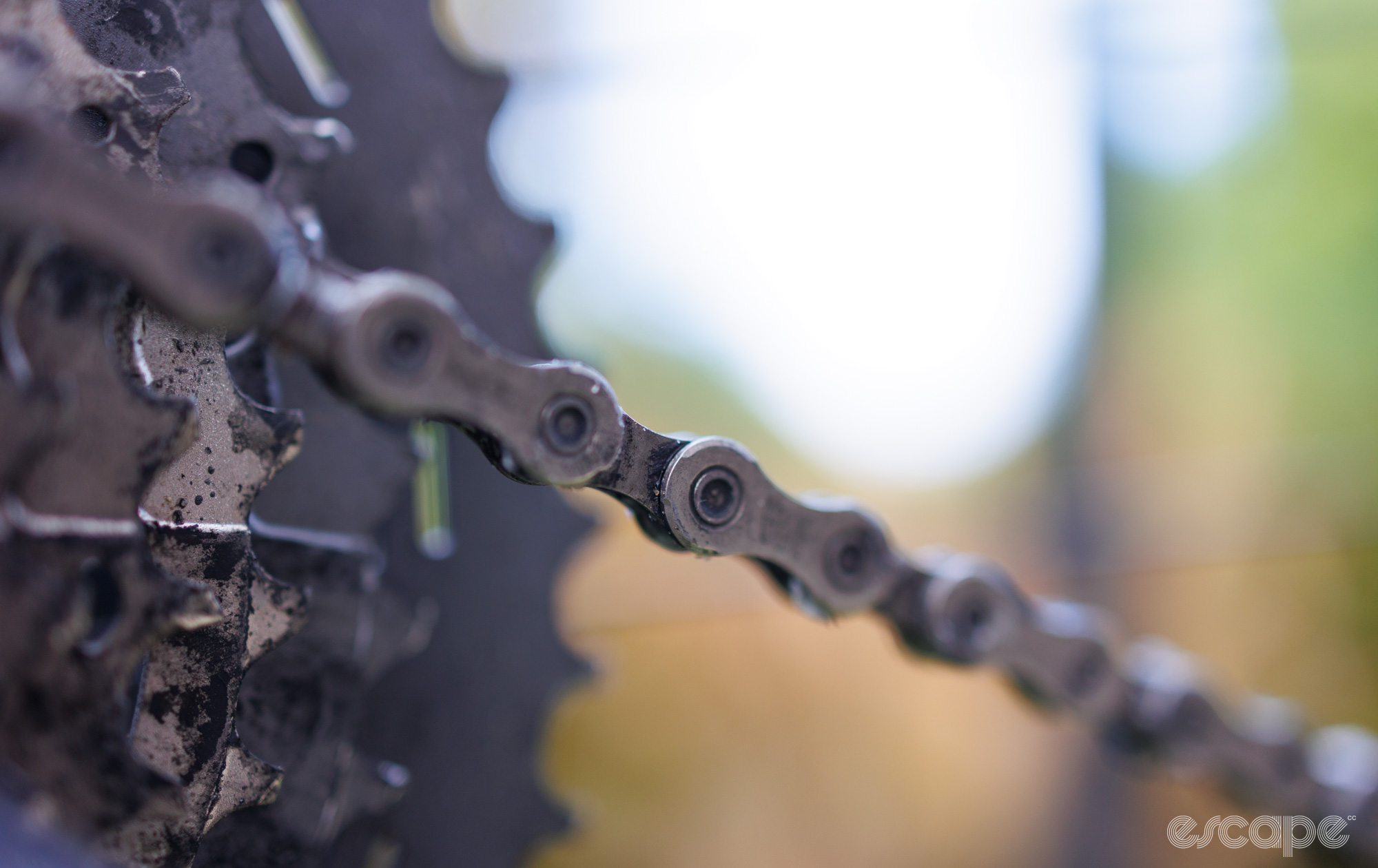Riding a well-tuned bike can go a long way to achieving a mind-cleansing and joy-inducing pedal. By contrast, creaking and squeaking your way up a climb can quickly take the smile off even the rosiest of cyclists.
This article is intended for road (and gravel) riders who may not be so keen on the tech side of cycling. Consider this an essential hit list of the most common tech misunderstandings and woes a tech-loving and/or mechanic would wish you to know. Likewise, if you’ve got a friend who always has the noisiest bike in the group, please send this as a reminder that they’re overdue for their next bike service.
In no particular order, here’s a list of techy things professional mechanics wish all cyclists would know about and pay attention to. And yes, tech lovers can expect deeper dives on many things covered here.
Related reading: Things bike fitters wish all cyclists knew.
Lower tyre pressures are better, to a point
The science of tyre pressure has come a long way in recent years. The days of running 23 mm tyres at 110 psi to go fast are in the past.
Now we know that wider tyres with more air volume run at lower pressures are more efficient on less-than-glass-smooth road surfaces – and you can bet they’re more comfortable and offer more confident handling, too. The goal is to run the pressures low enough to keep the tyres grounded, but not so soft that you’re at risk of flatting it if you hit a pothole or similar square-edge bump.
In most cases, people tend to run too much tyre pressure for their weight – especially when you consider that the wider the tyre, the lower the pressure you need to run. As an example, a decade ago I was running my 25 mm tyres at 100 psi (with a body weight of 70 kg); now, I typically run that same size tyre closer to the high 70s range.
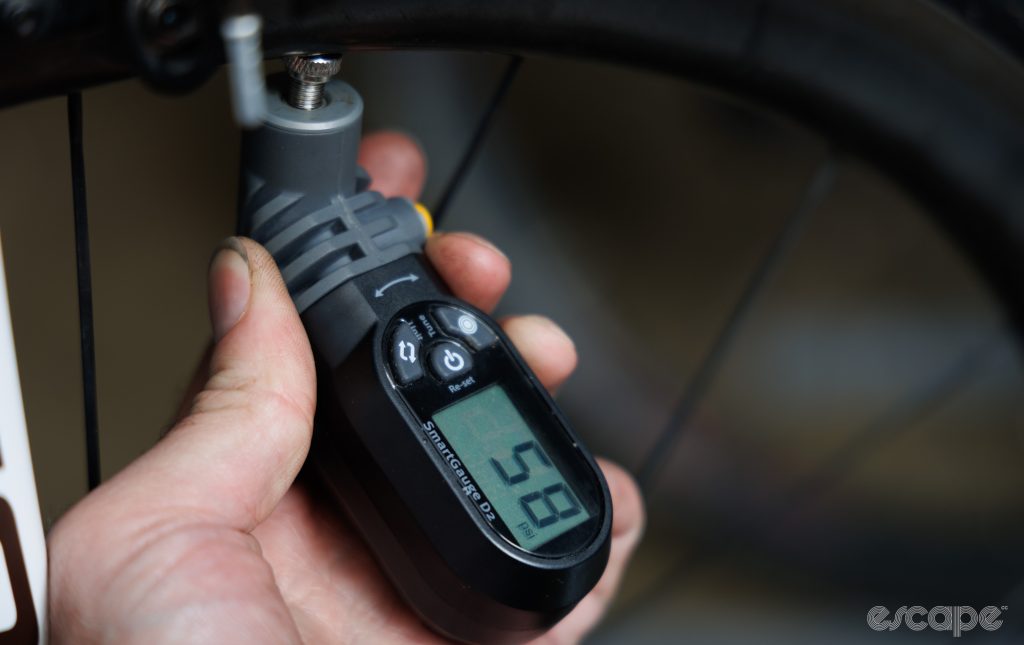
Like many tech topics in cycling, the rabbit hole runs deep on this one. However, following the pressure recommendations provided by a free pressure calculator such as Silca’s is a quick way to find more comfort and efficiency without spending a cent. Use the results as a starting point for experimenting with slightly higher and lower pressures to find out what feels and works best for you.
Related, it’s important to remember that bicycle tyres experience air loss rapidly compared to the tyres of a motor vehicle. Checking and adding pressure to a tyre before every ride is normal.
A clean chain saves big money
“What do you wish all cyclists knew” is a question I posed to a handful of highly experienced mechanics, and all answered with something related to drivetrain maintenance and wear.
“The number one issue I see on bikes is mistreated drivetrains. There have been so many advancements in lubes and cleaners, but most of that information hasn’t made its way to the mainstream sources,” said Colorado-based mechanic Colin Williams. And accelerated wear means accelerated replacement costs. “With consumable drivetrain parts on mid to high-end bikes priced around the same as an entry-level alloy complete bike, there is a lot of benefit to be found in proper drivetrain care,” Williams added.

Your choice in chain lubricant and how clean you keep the drivetrain can be the difference between getting as little as 500 km or as much as 15,000 km from a chain. And as a bonus, a well-lubed and clean chain saves significant watts and greatly improves shifting performance.
Zero Friction Cycling is an independent voice in the space that offers a detailed resource for picking a great chain lube that will ensure you get the most value from your drivetrain. Some basic tips include avoiding chain lubes that claim to be cleaners and lubricants in a single bottle, and not using general household products for either task. Many of the consistently best-performing drip-on lubricants come from brands such Rex, Tru-Tension, CeramicSpeed, Effetto Mariposa, and Silca. Just be warned, many of the good ones require you to degrease the drivetrain before the first application.
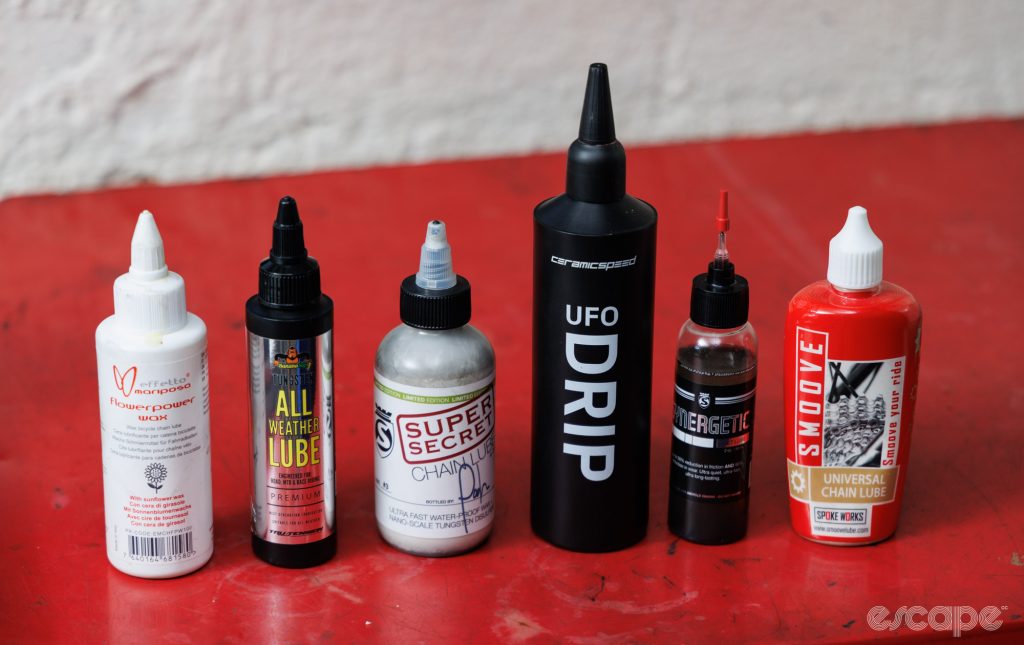
“Drivetrain wear in all forms,” is the one thing superstar mechanic Brad Copeland would like more riders to be savvier to. “And it happens faster than most people realize and has sad implications when it catches up to those who didn’t realize.”
To Copeland’s point, checking for elongation-based chain wear (commonly known as chain stretch) and replacing worn chains regularly can often save you from prematurely wearing out that expensive cassette and chainrings. I recommend buying a chain wear checker tool and regularly using it. For 8-10 speed bikes, aim to replace the chain as soon as it shows 0.75% wear. For 11-, 12-, and 13-speed bikes, you’ll benefit from changing the chain as soon as it shows 0.5% wear.
I typically recommend the Park Tool CC-4 and Pedro’s Chain Checker Plus II for affordable chain wear checkers. The slightly complicated benefit to these two tools is that they isolate roller size from the measurement and are therefore reliable to use on all chain types, including SRAM’s Flat Top 12-speed chains with oversized rollers.

Expect more coverage on drivetrain wear, cleaning, and lubrication in the near future.
The trim function
This one applies to those running Shimano mechanical shifting (aka, not electronic) on a dropbar bike. Did you know the front shifter has middle positions?
“We often get customers with difficulties getting their Shimano dropbar gears to run properly. And then it turns out they don’t know about front derailleur trim, many having ridden (many) years on such drivetrains,” said Jon Lindgren (aka angrybikemechanic).
Indeed this is a commonly unknown feature, and not using it presents itself as a chain noise on the front derailleur in certain gear combinations. If you experience chain rub when in the big chainring at the front and the biggest cogs on the cassette (rear wheel), you can give a very gentle click to the smaller shift button (left-hand shifter) to move the derailleur cage slightly inboard without dropping to the small ring – if the system is correctly adjusted this will solve the rubbing. The same feature exists when in the small chainring.
Related, this is one of the subtle benefits of expensive electronic shifting as the trim feature is automated.
Sudden changes in shifting mean something is awry
Did you have perfect rear shifting the last ride, and suddenly it’s playing up? This is something to look into sooner than later.
There can be a number of causes, but there are two standouts. The first is a bent derailleur hanger (the piece that connects the rear derailleur to the frame) which can cause the derailleur to sit at an angle. This is a surprisingly common issue as many road and gravel bikes feature derailleur hangers made of relatively soft metal, which can go out of alignment merely by laying another bike on them, having the bike blow over at the cafe, or similar.
The second cause of a sudden deterioration in shift quality is often a frayed inner cable (assuming you don’t have electronic shifting). For the rear shifting, a frayed cable will first present as sudden reluctant shifting into your hardest gear (smallest cog at back). Once a cable has begun fraying, it won’t take long to break, leaving you stuck in the hardest gear. A sudden increase in effort to move the shift lever – particularly for front derailleur shifts – can also be a sign of rising friction from a fraying cable.

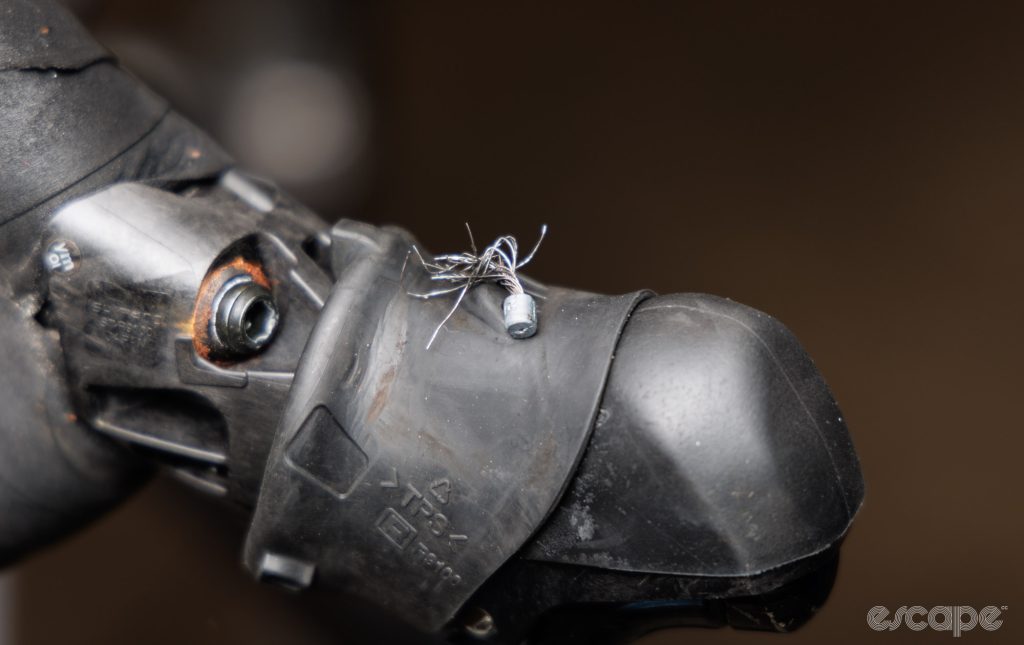
Brake warnings
“The other big issue I see is hydraulic disc brakes being neglected,” said Colin Williams. These systems are so reliable they can seem like set-and-forget, but “if you live in a hilly area, it’s not unreasonable to have to flush and bleed those systems two or more times a year.” Whatever terrain you ride in, a good schedule is to have hydraulic disc brakes bled annually, even if they seem to be working fine.
Indeed the fluid in those fancy new hydraulic brakes is perishable. Long-term neglect can cause internal clogging of the fluid parts and spell bad news on the service bill.
Perhaps even more critical to brake function is paying attention to pad and rotor wear. “Proper measurement of rotors thickness is critically important on road bikes and is often missed. An inexpensive micrometre or caliper can take the guesswork out of measuring wearable brake parts,” said Williams. The minimum recommended rotor thickness is typically marked on your brake rotors.
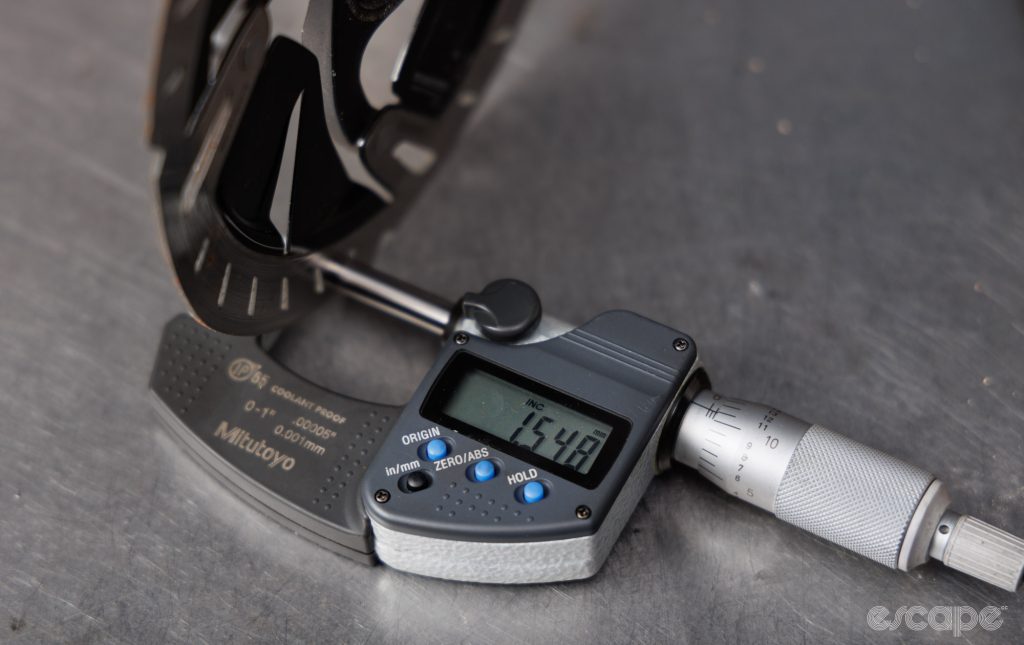
As for pad wear, your brakes typically warn you through a progressively more spongy feel at the lever, increasing noise while braking, and/or worsening stopping performance. SRAM says pads should be replaced when the total thickness (pad material and backing plate) drops under 3 mm. Shimano recommends replacing pads when the pad material itself (not including the backing plate) is less than 1 mm – slightly harder to measure, but perhaps a reason to get a good set of Vernier calipers. Campagnolo pads have wear indicators. As with all maintenance issues, a quick, regular check spots wear issues before they’re critical.
Annoying noises and movements need attention
When riding a well-kept bike you should hear little more than the whir of the chain and the rhythm of your tyres at their point of contact. All the things designed to move should do so with minimal effort, while the things not designed to move most certainly shouldn’t.
Any squeaks, creaks, groans or moans from your bike is often a sign that something is dry, loose, rubbing, slipping, or perhaps even cracked. And like the “check oil” light in a car, these noises are often your bike warning that something is wrong.
Similarly, if a wheel develops a side-to-side movement, or if your bike’s front fork and stem rock back and forth, then that’s a sign that something is loose and being worn away beyond its intended use. That loose-feeling fork is almost certainly a fairly simple headset adjustment, but riding with such a thing can quickly cause irreparable and downright-dangerous damage to the fork and even the frame.
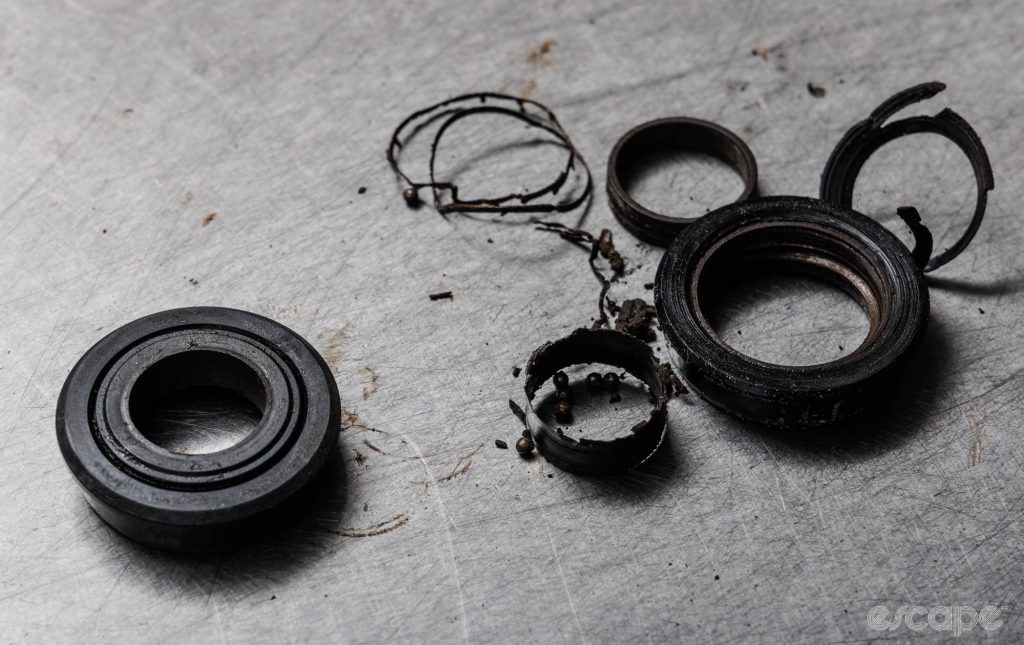
Pay attention to annoying noises or strange feelings from your bike that are either consistently there when pedaling or appear to be worsening. Try to note the circumstances: do you hear them only when pedaling, for instance? Those are diagnostic clues that will help a good mechanic resolve the issue more quickly (which may mean more affordably for you).
Sweat is corrosive
Just about everyone sweats; some sweat more than most.
Unfortunately, sweat is slightly acidic, which makes it corrosive to paint and metals, and leaving it to dry ride after ride eventually leads to component failure. And if you train indoors, this can happen within a single season.
If you know you’re a heavy sweater, try to give your bike a light rinse with water after hard rides – the shower setting of a garden hose is just right. And consider increasing the frequency of your bike services and bar tape replacement to ensure that corrosion isn’t lurking beneath – broken aluminium handlebars resulting from sweat are more common than you may think.
Preventative is the best kind of maintenance
So many topics covered within this article revolve around a common theme – regular care and maintenance. With regular cleaning and maintenance, many of the worst-case scenarios quickly become rare. Instead, you’ll experience your bike in a way that it was designed to be enjoyed.
Or put in a slightly more spicy way, Zach Edwards of the Boulder Groupetto says, “I don’t care if you never wash your bike in between trips to the shop if you’re accepting and knowing that things are going to need to be replaced.” And with bike parts more expensive than ever, a little maintenance goes a long way.
Got another tip? Become a member of the escapecollective.com to join the conversation in the comments section, and also gain access to all our entirely independent content, and our member-only Discord channel.
Next up are the things bike fitters wish every cyclist would know.
Did we do a good job with this story?
